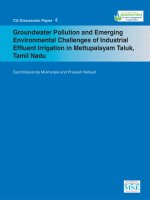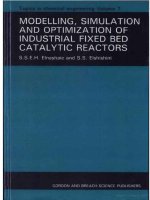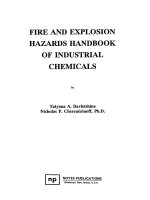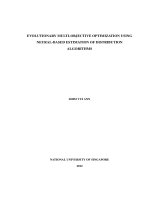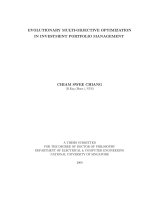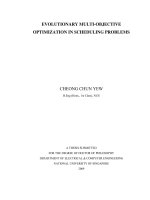Modeling, simulation and multi objective optimization of industrial, low density polyethylene reactor
Bạn đang xem bản rút gọn của tài liệu. Xem và tải ngay bản đầy đủ của tài liệu tại đây (2.74 MB, 195 trang )
MODELING, SIMULATION AND MULTI-OBJECTIVE OPTIMIZATION OF
AN INDUSTRIAL, LOW-DENSITY POLYETHYLENE REACTOR
NAVEEN AGRAWAL
NATIONAL UNIVERSITY OF SINGAPORE
2008
MODELING, SIMULATION AND MULTI-OBJECTIVE OPTIMIZATION OF
AN INDUSTRIAL, LOW-DENSITY POLYETHYLENE REACTOR
NAVEEN AGRAWAL
(B.Tech, Indian Institute of Technology, Roorkee, India)
A THESIS SUBMITTED
FOR THE DEGREE OF DOCTOR OF PHILOSOPHY
DEPARTMENT OF CHEMICAL AND BIOMOLECULAR ENGINEERING
NATIONAL UNIVERSITY OF SINGAPORE
2008
Acknowledgements
Acknowledgements
I wish to express my deepest gratitude to Gurumata Bijaya. By her blessings, I
always felt enlightened and peace of mind to face the challenges.
With all respect and gratitude, I wish to express my sincere thanks to my research
advisors, Prof. G. P. Rangaiah and Prof. A. K. Ray. They have provided me the
excellent guidance to work diligently and enthusiastically. I am overwhelmed with
their constant encouragement and providing greater insights, invaluable suggestions
and kind support for the last few years. I greatly respect their inspiration, unwavering
examples of hard work and professional dedication.
I would like to convey my sincere thanks to Prof. S. K. Gupta, IIT Kanpur, India
under whom I pursued part of my research. His mathematical expertise and wide
range of knowledge and expertise were always instrumental in providing me the
constant thrust to excel in research.
I would like to thank my parents and brothers for their affection, love and support
at every stage of my life.
I am extremely thankful to my loved one – Monu who always encouraged and
supported me with her deepest love and ideas.
I gratefully acknowledge the National University of Singapore which has provided
me excellent research facilities and financial support in the form of scholarship.
Many thanks to Mr. Boey and non-technical staff of the department for their kind
assistance in providing the necessary laboratory facilities and computational
resources.
Last but not the least, I am lucky to have many friends who always kept me
cheerful. I would like to thank Nidhi, Amit Gupta, Avinash Singh, Chand
i
Acknowledgements
Vishwakarma, Raju Gupta, Lee Nick, Yelneedi Sreenivas, Mekapati Srinivas, N. V.
S. Murthy Konda, M. K. Saravanan, Ankur Dhanik, Manish Mishra, Naveen Bhutani,
Bhupendra Singh, Lokesh B. Thiagarajan, G. Sundar, Ashok M. Prabhu, Desingh D.
Balasubramaniam, Neha Tripathi and Koh Niak Wu for the good times spent together.
ii
Table of Contents
Table of Contents
Acknowledgements
i
Table of Contents
iii
Summary
v
Nomenclature
viii
List of Figures
xiii
List of Tables
xviii
1 Introduction
1.1 Polyethylene and its Significance 1
1.2 LDPE Process Technology 3
1.3 LDPE Reactor Modeling and Optimization 5
1.4 Motivation and Scope of Work 8
1.5 Organization of Thesis 11
2 Literature Review
2.1 Introduction 14
2.2 Reaction Kinetics 15
2.3 Reactor Modeling and Simulation 19
2.4 LDPE Tubular Reactor Optimization 23
2.5 Summary 27
3 Genetic Algorithms and Constraint-handling Techniques for MOO
3.1 Introduction 28
3.2 Genetic Algorithms for Multi-objective Optimization 28
3.3 NSGA-II and its JG Variants 31
3.4 Penalty Function Method 34
3.5 Constrained-dominance Principle for Handling Constraints 35
3.5.1 Implementation and Testing 36
3.5.2 Results and Discussion 38
3.6 Conclusions 43
4 Reactor Modeling, Simulation and Optimization
4.1 Introduction 45
4.2 Reactor Modeling and Simulation 50
4.2.1 Formulation 50
4.2.2 Estimation of Model Parameters 59
4.3 Multi-objective Optimization of LDPE Tubular Reactor 67
4.3.1 Formulation 67
4.3.2 Results and Discussion 70
4.3.3 Four-objective Optimization 85
4.4 Conclusions 88
5 Design Stage Optimization
5.1 Introduction 89
5.2 Modeling and Simulation of LDPE Tubular Reactor 92
5.3 Multi-objective Optimization 95
5.3.1 Formulation 95
5.3.2 Results and Discussion 97
iii
Table of Contents
5.3.3 Constraint Handling by Constrained-dominance Principle 106
5.3.4 Three-objective Optimization 117
5.4 Conclusions 123
6 Dynamic Modeling, Simulation and Optimal Grade Transition
6.1 Introduction 124
6.2 Dynamic Modeling and Simulation 127
6.3 Effects of Changes in the Operation Variables 133
6.4 Optimal Grade-change for LDPE Tubular Reactor 137
6.4.1 Formulation 137
6.4.2 Results and Discussion 144
6.5 Conclusions 151
7 Conclusions and Recommendations
7.1 Conclusions 153
7.2 Recommendations for Future Work 156
References
159
Appendices
A. Moment Closure Technique by Assuming a Log-normal
Distribution
171
B. Publications and Presentations of this Author 174
iv
Summary
Summary
Products made from polyethylene are very common in everyday life; these include
kitchenware, containers for pharmaceutical drugs, wrapping materials for food and
clothing, high frequency insulation, and pipes in irrigation systems. A very flexible
and branched low density polyethylene (LDPE) is obtained commercially by high-
pressure polymerization of ethylene, in the presence of chemical initiators (i.e.,
peroxides, oxygen, azo compounds), in long tubular reactors or well-stirred
autoclaves. The polymerization in tubular reactors involves very severe processing
conditions such as pressures from 150 – 300 MPa and temperatures from 325 – 625 K.
No work in the open literature discusses multi-objective optimization (MOO) of
LDPE tubular reactors even though multiple objectives are essential for overall
optimum operation. Also, understanding the dynamic behavior of tubular reactor is
essential in order to produce optimally thirty to forty grades of polymer in a single
plant. Hence, this study focuses on modeling and simulation of LDPE tubular reactor
and its optimization for multiple objectives for operation, design and grade-change
policies.
A detailed survey of modeling studies on LDPE tubular reactors in the literature
showed significant discrepancies in the kinetic rate parameters from different sources.
Therefore, these kinetic data can not be relied on for simulation and optimization.
Some authors have obtained these parameters by validating industrial results but they
did not reveal the values of some parameters due to proprietary reasons. Thus, in our
study, best-fit values of the model parameters are obtained by comparing the
predictions with the available industrial data. This steady-state model is then used for
v
Summary
multi-objective optimization of an industrial LDPE reactor. Further, the reactor model
with all parameter values, developed in this study, is available for any one to use.
Multiple objectives are important to the industry for best utilization of resources.
The productivity of LDPE using high-pressure technology in industrial tubular reactor
is reported to be 30 – 35% per pass which is quite low. At the same time, severe
operating conditions deteriorate quality of the polymer due to formation of undesired
side products (short chain branching and unsaturated groups). Therefore, reactors
should be operated so as to minimize these side products and maximize the monomer
conversion for a given feed flow rate, while the LDPE produced should have the
desired properties defined in terms of number-average molecular weight. All these
lead to constrained, multi-objective optimization problem.
In this study, the multi-objective problem for an industrial LDPE reactor is solved
at both operation and design stage, using a binary-coded elitist non-dominated sorting
genetic algorithm (NSGA-II) and its jumping gene (JG) adaptations. The difficulty in
finding appropriate penalty parameter in penalty function approach led us to
implement a systematic approach of constrained-dominance principle for handling the
constraints in the binary-coded NSGA-II-JG and NSGA-II-aJG. The effectiveness of
this approach is evaluated for the design stage MOO of the industrial LDPE reactor.
The Pareto-optimal sets for both operation and deign problems are obtained. The
results show that much higher monomer conversion at relatively lower side products
can be obtained compared with the current industrial operating condition. The Pareto-
optimal set gives many equally good points (non-dominated solutions) to the decision
maker so that s/he can use her/his industrial experience and intuition to select one of
these points for process design and/or operation.
vi
Summary
A multitude of LDPE grades is usually produced from a single reactor. The major
task in the operation of a tubular LDPE reactor is the minimization of off-spec
polymer production during a grade transition. Hence, a comprehensive dynamic
model is developed and used for optimizing the grade-change policies so as to
minimize the grade change-over time and off-spec polymer defined in terms of
polymer properties. The Pareto-optimal solutions of this dynamic optimization
problem are successfully obtained using NSGA-II-aJG. The resulting optimal grade-
change policies are better in terms of reaching the new steady-state faster with
relatively less off-spec product.
Considering the unavailability of complete details of an LDPE tubular reactor
model in the open literature and lack of MOO studies on LDPE reactors for
industrially important objectives, the present work, its approach and results are of
significant interest to both researchers and practitioners.
vii
Nomenclature
Nomenclature
A frequency factor (1/s; m
3
/kmol-s; m
3.3
/kmol
1.1
-s)
C
i
concentration of the i
th
component (kmol/m
3
)
C
P
specific heat of the reaction mixture (kJ/kg-K)
D
e
equivalent diameter of the jacket (m)
D
int
inside diameter of reactor (m)
D
jacket
inner diameter of jacket wall (m)
D
o
outer diameter of the inner (reactor) pipe (m)
E activation energy (kJ/kmol)
E
v
activation energy for viscous flow (kJ/kmol)
F
i
flow rate of the i
th
component (kg/s)
f
m
initiator efficiency
f
r
friction factor
G
i
i
th
objective function in multi-objective optimization problem
J
i
i
th
objective function
ΔH heat of polymerization (kJ/kmol)
h
i
inside (the reactor) film heat transfer coefficient (W/m
2
-K)
h
o
outside (jacket side of reactor) film heat transfer coefficient (W/m
2
-K)
h
w
wall (reactor) heat transfer coefficient (W/m
2
-K)
I
i
i
th
initiator
K thermal conductivity of the reaction mixture (W/m-K)
k kinetic rate constant (1/s; m
3
/kmol-s; m
3.3
/kmol
1.1
-s)
L reactor length (m)
l
aJG
length of the replacing jumping gene
viii
Nomenclature
l
chrom
total length (number of binaries) of a chromosome
l
substr
length (number of binaries) of a substring representing a decision
variable
L
t
total reactor length (m)
L
zi
axial length of i
th
zone (m)
M monomer
M' molecular weight of ethylene (kg/kmol)
M
e
methyl end group (short-chain branches)
M
n
number-average molecular weight
N
gen
generation number
N
pop
total number of chromosomes in the population
Nu Nusselt number
o oxygen (initiator)
P reactor pressure at any axial position (MPa)
Pr Prandtl number
P
c
critical pressure (MPa)
P
i
(x) dead polymer molecule with x monomer units and i long-chain
branches
p
c
crossover probability
p
JG
jumping probability for the JG operator
p
m
mutation probability
R ideal gas constant (kJ/kmol-K)
Re Reynolds number
R
i
(x) growing macro-radical with x monomer units and i long-chain
branches
ix
Nomenclature
S solvent (telogen)
S
r
seed for random number generator
T temperature of the reaction mass (K)
T
c
critical temperature (K)
T
J,i
jacket fluid temperature in the i
th
jacket (K)
T
r
reduced temperature
U overall heat transfer coefficient (W/m
2
-K)
ΔV activation volume (m
3
/kmol)
V
i
vinyl group
V
id
vinylidene group
V
J,i
flow rate of jacket fluid in i
th
jacket (m
3
/s)
V
M
specific volume of monomer (kg/m
3
)
V
p
specific volume of polyethylene (kg/m
3
)
v velocity of the reaction mixture (m/s)
v
J,i
velocity of coolant in the i
th
jacket (m/s)
w
i
weighting factor in the i
th
objective function
W
M
monomer weight fraction
W
p
polymer weight fraction
X
M
monomer conversion at any axial position
z axial distance (m)
Greek symbols
ΔP pressure drop (MPa)
δ
ij
delta of Kronecker
η dense gas viscosity of the monomer (Pa-s)
x
Nomenclature
η
o
low-pressure monomer viscosity (Pa-s)
η
s
viscosity of the ethylene-polyethylene solution (Pa-s)
λ
np
n, p order moments for the chain length distribution of macro-radicals
(kmol/m
3
); n = 0, 1; p = 0, 1, 2
μ
J
viscosity of the jacket fluid (Pa-s)
μ
np
n, p order moments for the chain length distribution of the dead
polymer molecules (kmol/m
3
); n = 0, 1; p = 0, 1, 2
ξ defined in Eq. 4.6b in Table 4.2 (Pa-s)
-1
ρ density of the reaction mixture (kg/m
3
)
ρ
J
density of the jacket fluid (kg/m
3
)
ρ
M
monomer density (kg/m
3
)
ρ
r
reduced density
Subscripts
b β-scission of a secondary radical
bb backbiting
b1 β-scission of a tertiary radical
d desired value
dm decomposition of m
th
peroxide (initiator); m = 1, 2
f (final) reactor exit
I,m m
th
initiator; m = 1, 2
in inlet of reactor
J jacket
M monomer
M
e
methyl end group
xi
Nomenclature
max maximum
O
oxygen (initiator)
p propagation
S solvent
tc termination by combination
tdt thermal degradation
trm chain transfer to monomer
trp chain transfer to polymer
trs chain transfer to telogen or solvent
V
i
vinyl group
V
id
vinylidene group
xii
List of Figures
List of Figures
Figure 1.1 Molecular Structure: Branched Vs Linear Polyethylene
2
Figure 1.2 Simplified Diagram of the High-pressure Polyethylene
Process
4
Figure 3.1 Flow chart of NSGA-II and its JG adaptations
33
Figure 3.2
Pareto-optimal sets by NSGA-II-RC (○) and NSGA-II-aJG
(Δ) for the CONSTR problem.
39
Figure 3.3 Pareto-optimal sets by NSGA-II-RC (○) and NSGA-II-aJG
(Δ) for the SRN problem.
40
Figure 3.4 Pareto-optimal sets by NSGA-II-RC (○) and NSGA-II-aJG
(Δ) for the TNK problem.
44
Figure 3.5 Pareto-optimal sets by NSGA-II-RC (○) and NSGA-II-aJG
(Δ) for the WATER problem.
45
Figure 4.1 Schematic diagram of an industrial LDPE reactor
52
Figure 4.2
Model predictions; (▼): industrial data; (♦): industrial
estimate
and (■): industrial estimates for the LDPE reactor
of Figure 4.1.
66
Figure 4.3 (a) Converged solutions for several end-point constraints
on M
n,f
using NSGA-II. Numbers in parenthesis refer to the
number of generations. (b) The results of Figure 4.3a are
re-plotted with vertical shifts of 0.2 (i.e., the values of the
ordinate for M
n,f
= 21900 ± 20 kg/kmol are displaced
vertically upwards by 0.2, etc.)
73
Figure 4.4 (a) Converged Pareto-optimal sets for M
n,f
= 21900 ± 200
kg/kmol using NSGA-II and its JG adaptations. Numbers
in parenthesis indicate the number of generations. (b)
Results of Figure 4.4a re-plotted with vertical shifts of 0.2,
as in Figure 4.3b.
74
Figure 4.5 (a) Pareto-optimal sets for M
n,f
= 21900 ± 200 kg/kmol
(reference case) using NSGA-II-aJG for different number
of generations (indicated in parenthesis). (b) Results of
Figure 4.5a re-plotted with vertical shifts of 0.2, as in
Figure 4.3b.
76
Figure 4.6 (a) Converged Pareto sets for problems having different
end-point constraints on M
n,f
using NSGA-II-aJG.
77
xiii
List of Figures
Numbers in parenthesis indicate the generation numbers.
(b) Vertically shifted converged Pareto sets of Figure 4.6a
(as in Figure 4.3b)
Figure 4.7 Solutions for M
n,f
= 21900 ± 0 kg/kmol using NSGA-II and
its JG adaptations. Numbers in parenthesis indicate the
generation number. Results for NSGA-II-aJG (1050) and
NSGA-II (1600) are the same as those in Figures 4.6 and
4.3, respectively.
80
Figure 4.8 Points having M
n,f
= 21900 ± 0.1 kg/kmol from among the
Pareto sets of Figure 4.6a. These points are compared to
the reference case.
83
Figure 4.9 Pareto-optimal points and the corresponding decision
variables and constraints for the reference case (M
n,f
=
21900 ± 200 kg/kmol; NSGA-II-aJG). Industrial data (▼)
are shown.
84
Figure 4.10 Temperature, monomer conversion and number-average
molecular weight profiles for chromosomes A ( ), B (―)
and C (− − −) shown in Figure 4.9a
85
Figure 4.11 Effect of F
M
on the Pareto-optimal set (reference case)
86
Figure 4.12 Results for the 4-objective optimization problem in
Equation 4.5 (NSGA-II-aJG)
87
Figure 5.1 Converged solutions for several end-point constraints on
M
n,f
using NSGA-II. Numbers in parenthesis refer to the
number of generations.
101
Figure 5.2 (a) Converged Pareto-optimal sets for M
n,f
= 21900 ± 200
kg/kmol using NSGA-II and its JG adaptations. Numbers
in parenthesis indicate the number of generations. (b) The
results of Figure 5.2a are re-plotted with vertical shifts of
0.2 (i.e., values of the ordinate are displaced vertically
upwards by 0.0, 0.2, or 0.4).
102
Figure 5.3 Converged Pareto sets for problems having different end-
point constraints on M
n,f
using NSGA-II-aJG. Numbers in
parenthesis indicate the generation numbers.
103
Figure 5.4 Converged Pareto sets for problems having different end-
point constraints on M
n,f
using NSGA-II-JG. Numbers in
parenthesis indicate the generation numbers.
103
Figure 5.5 Converged Pareto sets for M
n,f
= 21900 ± 2 kg/kmol using
NSGA-II and its JG adaptations. Numbers in parenthesis
indicate the generation number. Results for NSGA-II-aJG
104
xiv
List of Figures
(19500) and NSGA-II-JG (21000) are the same as those in
Figures 5.3 and 5.4, respectively
Figure 5.6 Solutions for M
n,f
= 21900 ± 0 kg/kmol using NSGA-II and
its JG adaptations
104
Figure 5.7 Points satisfying M
n,f
= 21900 ± 2 kg/kmol from among the
Pareto sets of M
n,f
= 21900 ± 200 kg/kmol and M
n,f
=
21900 ± 20 kg/kmol cases using NSGA-II-aJG. These
points are compared to the reference case.
105
Figure 5.8 Converged Pareto-optimal sets for M
n,f
= 21900 ± 200
kg/kmol using NSGA-II-aJG for constrained-dominance
principle and penalty function method. Pareto-optimal sets
for 2500 and 3000 generations using the latter method are
plotted with a vertical shift to show the convergence.
108
Figure 5.9 Pareto-optimal solutions for M
n,f
= 21900 ± 2 kg/kmol
using NSGA-II-aJG for constrained-dominance principle
and penalty function method. These solutions are
compared to those for the reference case
108
Figure 5.10 Points satisfying M
n,f
= 21900 ± 2 kg/kmol from among the
Pareto sets of M
n,f
= 21900 ± 200 kg/kmol and M
n,f
=
21900 ± 20 kg/kmol cases using NSGA-II and its JG
adaptations and constrained-dominance principle. These
solutions are compared to those for the reference case.
109
Figure 5.11 Pareto-optimal points and the corresponding decision
variables and constraints for the reference case (M
n,f
=
21900 ± 200 kg/kmol) using NSGA-II-aJG. The Pareto-
optimal points for design stage (○) are compared to those
for the operation stage optimization (Δ) in Figures 5.11a
and p.
112
Figure 5.12 Temperature (T), monomer conversion (X
M
), and initiator
concentrations profiles for chromosomes A ( ), B (-·-·-·-),
B’ (―) and C (− − −) shown in Figure 5.11a
113
Figure 5.13 Pareto-optimal points and the corresponding decision
variables and constraints for the reference case (M
n,f
=
21900 ± 200 kg/kmol) using NSGA-II-JG
115
Figure 5.14 Pareto-optimal solutions for M
n,f
= 21900 ± 200 kg/kmol
using NSGA-II-aJG with and without penalty on C
I,2,f
116
Figure 5.15 Pareto-optimal solutions for M
n,f
= 21900 ± 200 kg/kmol
using NSGA-II-aJG with and without minimization of
SCB
117
xv
List of Figures
Figure 5.16 Simplified process flow diagram of the LDPE production
119
Figure 5.17 Results for the three-objective optimization problem using
NSGA-II-aJG
119
Figure 5.18 Comparison of Pareto sets obtained for (a) normalized side
products Vs X
M,f
and (b) compression power Vs X
M,f
, from
the three-objective optimization (Δ) and two-objective
optimization of normalized side products and X
M,f
(○)
121
Figure 5.19 Comparison of Pareto sets obtained for (a) normalized side
products Vs X
M,f
and (b) compression power Vs X
M,f
from
three-objective optimization (Δ) and two-objective
optimization of compression power and X
M,f
(○)
122
Figure 5.20 Objectives, selected decision variables and constraints
corresponding to the Pareto-optimal points for the three-
objective optimization problem for the reference case (M
n,f
= 21900 ± 200 kg/kmol) using NSGA-II-aJG.
122
Figure 6.1 Effect of step size on the histories of the values at the exit
of the reactor: (a) temperature (T
exit
), (b) monomer
conversion (X
M,exit
), (c) number-average molecular weight
(M
n,exit
), and (d) normalized side products (NSP
exit
) at the
reactor exit
133
Figure 6.2
Transient profiles for a step decrease in F
S
alone: (a)
variation of the solvent concentration along the reactor axis
at different times, (b) variation of the solvent concentration
at the reactor exit, (c) variation of M
n
along the reactor axis
at different times, and (d) variation of M
n
at the reactor exit
135
Figure 6.3 Transient data for a step increase in F
I,2
: (a) variation of T
along the reactor axis at different times, (b) T
exit
, and (c)
X
M,exit
136
Figure 6.4 Transient profiles of (a) X
M
and (b) M
n
along the reactor
axis, for simultaneous step changes in F
S
, F
I,1
, P
in
, and F
I,2
136
Figure 6.5 Pareto optimal solutions and the corresponding decision
variables for the initial grade, A (M
n,exit
= 21900 ± 200
kg/kmol) using NSGA-II-aJG
142
Figure 6.6 Pareto optimal solutions and the corresponding decision
variables for the final grade, B (M
n,exit
= 29000 ± 300
kg/kmol) using NSGA-II-aJG
142
Figure 6.7 Ramp trial function for the discretization of the decision
variable, F
S
(t)
143
xvi
List of Figures
Figure 6.8 Non-dominated solutions for the 2-objective optimization
problem in Equation (6.8) (ISE approach) using NSGA-II-
aJG, at different number of generations
146
Figure 6.9 Histories of the squared errors of: (a) M
n,exit
, (b) NSP
exit
,
and the optimal histories of: (c) M
n,exit
, and (d) NSP
exit
,
over the grade-change period for chromosome C in Figure
6.8.
147
Figure 6.10 Non-dominated sets for the two objectives in Equation
(6.9) (ITAE approach) using NSGA-II-aJG, at different
number of generations
148
Figure 6.11 Histories of the product of the time and the absolute error
(TAE) of: (a) M
n,exit
, (b) NSP
exit
, and the optimal histories
of: (c) M
n,exit
, and (d) NSP
exit
over the grade-change period
for chromosomes D ( ) and E (―) in Figure 6.10
149
Figure 6.12 Optimal grade-change histories of the four decision
variables for the MOO problem in Equation (6.9) (ITAE
approach): flow rates of solvent (F
S
), initiator 1 (F
I,1
), and
initiator 2 (F
I,2
) and the inlet pressure (P
in
) for
chromosomes D ( ) and E (―) in Figure 6.10
151
xvii
List of Tables
List of Tables
Table 3.1 Constrained test problems used in this study
38
Table 4.1 Kinetic Scheme and Model Equations for the LDPE Reactor
53
Table 4.2 Property Correlations
55
Table 4.3 Details of the Industrial LDPE Tubular Reactor Studied
58
Table 4.4 Rate Constants
60
Table 4.5 Bounds, Final Tuned Values, and Reported Values of the
Parameters
63
Table 4.6 Values of the (best) Computational Parameters Used in
Binary-coded NSGA-II, NSGA-II-JG, and NSGA-II-aJG
63
Table 4.7 Comparison of the Model-Predicted Values to the Industrial
Data
64
Table 5.1 Objectives, constraints and decision variables in the MOO
97
Table 5.2 Values of the computational parameters used in the binary-
coded NSGA-II, NSGA-II-JG, and NSGA-II-aJG for two-
objective design optimization
101
Table 6.1 Design and operating conditions of the industrial LDPE
tubular reactor studied
131
Table 6.2 Steady-state operating conditions and product specifications
for the initial (A) and final (B) grades
143
Table 6.3 Values of the computational parameters used in the binary-
coded NSGA-II-aJG for the two-objective dynamic
optimization problem
145
xviii
Chapter 1 Introduction
Chapter 1
Introduction
1.1 Polyethylene and its Significance
Products made from polyethylene (PE) are very common in everyday life. The
prevalence of polyethylene can be noted by the variety of products made form
polyethylene such as kitchen utility ware, containers for pharmaceutical drugs,
wrapping materials for food and clothing, high frequency insulation, and pipes in
irrigation systems. PE is the largest production polymer with annual worldwide output
of almost 84 millions tonnes (Kondratiev and Ivanchev, 2005). 25% of this is low-
density polyethylene (LDPE) produced in auto-clave and tubular high-pressure
reactors and remaining comprises of high-density polyethylene (HDPE) and linear
low-density polyethylene (LLDPE) in low pressure reactors. The production of LDPE
at high-pressure using tubular reactors is an important commercial process despite
many developments in low-pressure processes such as gas phase and slurry
polymerization.
Density and degree of branching are the most important physical and molecular
characteristics of PE, respectively. In the past, the PE industry was conveniently
classified by product density and process type. LDPE, in the density range of 910 to
925 kg/m
3
, is manufactured by a high-pressure process. Medium density polyethylene
lies in the range of 926 to 940 kg/m
3
. HDPE (Linear Polyethylene), synthesized by a
low pressure process, has a density in the range of 941 to 961 kg/m
3
(Kiparissides et
al., 1993a). Low pressure processes are further classified into three categories namely
suspension process, solution process, and gas process. LLDPE comprising a wide
density range of 880 to 950 kg/m
3
is produced at low pressure by copolymerization of
1
Chapter 1 Introduction
ethylene with an alpha-olefin, such as 1-butene, 1-hexene or 1-octene. Polymer chains
are branched at high temperature due to occurrence of side reactions. The density of
PE is determined by the degree of short chain branching (SCB). The density and
crystallinity are inversely proportional to the SCB. Today, PEs are more appropriately
described as branched PEs and linear PEs.
Branched PE is made with a free-radical catalyst and contains long-chain branches
(LCB). Linear PE is made with a transition metal catalyst and copolymerization of
ethylene with an alpha-olefin and contains no long-chain branching. Both branched
and linear PE may contain SCB as shown in Figure 1.1. The range of SCBs (CH
3
per
1000 C) for the three common PEs are:
LDPE: 10 – 50 [SCB = 30 per 1000 C (Gupta et al., 1985) for typical LDPEs]
HDPE: 2 – 3
LLDPE: 3 – 30
Figure 1.1 Molecular Structure: Branched Vs Linear Polyethylene
The molecular weight of LDPE ranges from waxy products at about 500 kg/kmol
to very tough products at about 60,000 kg/kmol. One unique feature of LDPE, as
opposed to HDPE or LLDPE, is the presence of both LCB and SCB along the
2
Chapter 1 Introduction
polymer chain. Another important feature of LDPE is its ability to incorporate a wide
range of comonomers that can be polar in nature along the polymer chain.
1.2 LDPE Process Technology
A very flexible and branched LDPE, typically in the range of 915 – 925 kg/m
3
, is
obtained commercially by high-pressure polymerization of ethylene, in the presence
of chemical initiators (i.e. peroxides, oxygen, azo compounds), in long tubular
reactors (Figure 1.2) or well-stirred autoclaves. This process in tubular reactors
involves extreme process conditions, namely, 150 – 300 MPa and 325 – 625 K.
A tubular reactor typically consists of several hundred meters of jacketed high-
pressure tubing as long as 1.6 km arranged as a series of straight sections connected
by 180 degree bends. Inner diameters of 25 – 75 mm have been quoted, but 60 mm or
somewhat larger is probably typical of modern tubular reactors. Wall thickness equal
to inner diameter is used to provide the necessary strength for the high-pressure
involved. The first section of the tubular reactor behaves as a preheater to raise
ethylene to a sufficiently high temperature for polymerization to start. This
temperature depends on initiator employed, ranging from 190 °C for oxygen to 140
°C for a peroxydicarbonate. The latter part of the tubular reactor acts as a product
cooler.
The heat of polymerization and specific heat of ethylene are 89.57 kJ/mol (3199
kJ/kg) and 2168 J/kg-K (Chen et al., 1976), respectively. Thus, adiabatic temperature
rise in the gas phase is around 15 °C for each 1% conversion of monomer to polymer.
Therefore, heat removal is a key factor in a commercial polymerization process. This
heat of reaction is partially transferred to water flowing co- or counter-currently
through the reactor jacket. But it is not possible to maintain isothermal conditions, and
temperature peaks occur.
3
Chapter 1 Introduction
Primary
compressor
Hyper
compressor
First zone
HP
separator
LP
separator
Vent
Initiator Initiator
Cooler
Cooler
Ethylene
Last zone
Tubular
Reactor
ExtruderPelletingPurge Bins
Air
Figure 1.2 Simplified Diagram of the High-pressure Polyethylene Process
Reactor feed includes ethylene, oxygen and/or initiators and chain transfer agents.
A commercial reactor may be divided into multiple reactor zones, heating and cooling
zones. However, multiple temperature peaks, responsible for increasing the
conversion, are obtained by injecting initiators, monomer, and solvents in different
tubular reactor zones. Conversion of ethylene is reported in the range of 20-35% in
the literature. PE is precipitated in the boundary layer (near to any relatively cold
surfaces in the reactor or downstream lines) due to its solubility in ethylene at very
high pressure. The build up of the polymer on the wall, if not removed, can lead to the
runaway reaction due to decreased heat transfer from the hot gas-polymer solution.
The precipitated PE from the wall is eliminated by opening the expansion valve more
fully than required, about once every 2 – 3 seconds, causing a decrease in pressure by
as much as 300 – 600 atm. The concomitant rapid increase in velocity of the gas
4
Chapter 1 Introduction
phase shears the walls and strips off any deposited PE so that a reasonably steady-
state heat transfer situation exists.
The product mixture containing unconverted ethylene and PE is sent to a series of
high- and low- pressure separators where polymer is obtained. These are also termed
as primary- and secondary separators. The unconverted ethylene is cooled and de-
waxed prior to being recycled to primary- and hyper- compressors, whereas molten
polyethylene obtained from the low pressure separator is fed into an extruder to be
pelleted, cooled and finally sent to storage.
1.3 LDPE Reactor Modeling and Optimization
In the past 30 years, various complex mathematical models have been developed
to produce LDPE in high-pressure tubular reactors. These models are reviewed in
detail in chapter 2 of this thesis. These models provide a sound basis for mathematical
description of production of LDPE in commercial plants. But, they sometimes present
complexities in the system. Thus, some assumptions are made to simplify the model
without loosing its validity in commercial processes. In particular, the following
model assumptions should be emphasized while studying a mathematical model in
LDPE tubular reactor.
1. Physical state of the reaction mass mixture – one phase versus two phase
system.
2. Kinetic mechanism and selection (estimation) of the kinetic parameters
3. Reactor flow conditions and mixing effects
4. Variation of the physical properties of the reaction mixture
5. Average jacket fluid temperature
5
